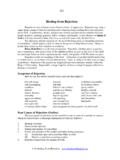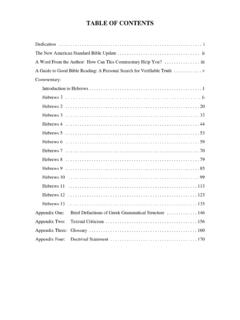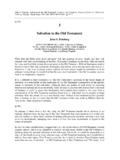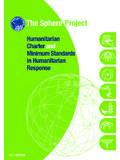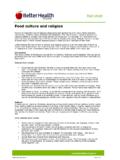Transcription of IVERMECTIN & THE MACROCYCLIC LACTONES SALVATION …
1 IVERMECTIN & THE MACROCYCLIC LACTONES SALVATION OR CURSE? Why these drugs may not be every dog s best defense against heartworm and other parasites When prevention and treatment can be worse than the disease What veterinary research found that the drug companies couldn t by Leslie Crane Rugg Any pet owner visiting a veterinary clinic in the last 15 years will have been mesmerized by the prominently displayed poster or model of an animal heart. This organ, reproduced in vivid, gory, technical detail, shows the hostile takeover by dirofilaria immitis, more commonly known and feared as heartworms. Tragic histories abound of once happy, carefree dogs, infected by mosquito bites, now reduced to radically sick shadows of their former active lives. Within their ravaged bodies, adult heartworms infested major organs, restricted blood flow in the arteries of the lungs, and produced thousands of larvae or microfilaria. Vigorous, healthy animals became weak vessels for proliferating spaghetti-like strands of voracious adult parasites; at the same time the larvae were marking time until another mosquito bit their host and carried them to yet another innocent victim to start the process all over again.
2 The only cure for adult heartworms has been drugs in the arsenic family. Although the poison itself vacates a dog s body within 24 hours, the dead worms often take two months or more to pass. Too often, a dog is so affected by the disease that the sheer mass of dead worms or the dog s own systemic immune reaction to the worms can hasten the end of the dog s life. The best chance for survival while under treatment for the disease has been to limit the animal s activity severely for at least one month. Only then will the dead worms decompose more safely and be efficiently absorbed by the immune system. Otherwise, the dog may die. Which is worse? The disease or the treatment? For the thousands of years since dogs have existed, the heartworm cycle has repeated itself, striking dogs initially in warm weather climates, eventually spreading worldwide. Only the cooler regions, where temperatures never climbed above 57 F, were spared.
3 Then the cycle was broken. As veterinary medicine progressed, a heartworm preventive was developed. Diethylcarbamazine (DEC) was given daily to dogs during mosquito season. However, if any of the daily doses were missed, the dog could still become infected with heartworms, and the potentially lethal, arsenic treatment was prescribed. In 1983, the first major advancement in prevention was introduced. A leading pharmaceutical company, Merck AgVet, promoted its newest, most comprehensive anti-parasiticide. Originally a product for horses and secondarily formulated for cattle, its developers thought it might be applied to dogs as well. The product contained IVERMECTIN the first MACROCYCLIC lactone - similar in human medicine to erythromycin but without the antibiotic effect. During the first few years of usage, a popular assumption was mistakenly made that these large animal formulations of IVERMECTIN could be successfully given to dogs.
4 Even though the off-label doses (inappropriate to species, size, and weight) were too high and too strong for dogs, few adverse incidents were reported. However, as off-label use became more widespread, a disturbing pattern emerged, particularly noticeable in one breed. Although many Collies were given high doses without the occurrence of toxic reaction, some Collies developed severe clinical signs, often resulting in death. Toxicosis typically occurred within 8-24 hours. Initial signs included dilated pupils, apparent blindness, and staggering. In some cases, these symptoms did not worsen and resolved without further distress. Moderate clinical signs included those mentioned and progressed to include lack of coordination and lateral recumbence (inability to stand). Severe signs included all of the aforementioned and led to coma and/or death, usually due to respiratory arrest. University studies investigated this phenomenon of erratic sensitivity, and results indicated that the pattern of toxicity was seen in families of Collies; clearly some sort of genetic link existed.
5 Armed with the knowledge that extremely low doses of IVERMECTIN were effective as a heartworm preventive, Merck AgVet, now known as Merial, Ltd., ordered further studies to ensure that a dog formulation would be safe for sensitive Collies as well. HEARTGARD , containing IVERMECTIN at a dose of 6 micrograms (mcg) per kilogram (kg) of body weight, was heralded as the most effective heartworm preventive available. It completely eliminated migrating larval forms of heartworms when dosage instructions were properly followed. Over time, other drug companies generated competitive heartworm preventives, each one with a different member of the MACROCYCLIC lactone family as its active ingredient. INTERCEPTOR contains milbemycin oxime. PROHEART contains moxidectin. REVOLUTION contains selamectin. Pet owners and veterinarians alike heaved grateful sighs of relief. A simple diagnostic blood test and effective preventives finally provided the answer to the debilitating disease and to the toxic cure.
6 A monthly tablet taken orally could truly eradicate the scourge of heartworm. And it did, saving countless numbers of dogs from misery and for the occasions when dogs received toxic doses of the preventives for which there is no known cure. Was the question going to be asked again? Was the disease or the prevention worse? The American Board of Veterinary Toxicology (ABVT) has recognized a series of clinical signs related to IVERMECTIN toxicity including mydriasis (pupil dilation), depression, coma, tremors, ataxia (loss of coordination), stupor, emesis (vomiting), drooling, and death. Merial Ltd. itself also reported in product information other adverse reactions such as lethargy, anorexia (loss of appetite), diarrhea, convulsions (seizures), paresis (paralysis), recumbency (immobile leaning/lying down), and excitability. Merial technical support veterinarian, Dr. Doug Carithers, attributes greater than 99% of reported canine toxic reactions to the result of individuals administering large animal formulations in an off-label manner.
7 Extremely rarely, he says, have such reactions resulted when farm dogs ingest the feces of cattle, sheep or horses that have also been given IVERMECTIN as an anti-parasiticide. Exposure to livestock-sized doses, even when fully metabolized by farm animals, may be strong enough to produce side effects in dogs that ranged from mild to lethal, from abnormal dilation of eye pupils to death. Dr. Carithers states, Merial has never had a documented case of IVERMECTIN toxicosis from appropriately administered HEARTGARD dosages. Adverse reactions typically occur when people give the wrong dose or misuse large animal formulations for small animals. It s like taking a whole bottle of aspirins instead of the recommended one or two. But problematic, unexplainable cases of toxic reactions persist, in which individual dogs of certain breeds don t tolerate doses specified by some as safe. The breeds most affected are closely related herding breeds.
8 Along with the Collie, anecdotal statistics claim Australian Shepherds, Bearded Collies , Border Collies, Old English Sheepdogs, and Shetland Sheepdogs as those breeds at high risk for IVERMECTIN toxicity. Similar suspicious events have added a variety of other breeds to this list from Whippets to Irish Water Spaniels to Bullmastiffs. Many of these breeds were ones already documented in veterinary journals as either proven or suspected to be hypersensitive to or intolerant of an assortment of medications including particular anesthesias and wormers. According to ABVT, the contrast between a sensitive breed such as the Collie and a tolerant breed such as the Beagle (the standard breed used in most animal trials) reveals the extraordinarily low dosage that elicits signs of IVERMECTIN toxicity. Collies are affected at a mere mg/kg or 15-30 times the therapeutic dose whereas Beagles only begin to be affected at mg/kg or greater than 200 times the therapeutic dose.
9 Collie sensitivity appears consistently with other MACROCYCLIC LACTONES as well. In studies done by Drs. William Tranquilli, Alan Paul and Kenneth Todd at the University of Illinois, mild signs of toxicity to milbemycin oxime were seen in Collies at 10 times the therapeutic dose for INTERCEPTOR . Despite the fact that drug companies responsible for mectin-based products had complied with Food and Drug Administration (FDA) regulations for adequate testing to certify safe usage by all breeds, the FDA further mandated that product labels caution about certain breeds extreme sensitivity. For example, the HEARTGARD label warns: Studies with IVERMECTIN indicate that certain dogs of the Collie breed are more sensitive to the effects of IVERMECTIN administered at elevated dose The relationship between pharmaceutical companies and the FDA attempts to unite science with legal and ethical requirements. Given the limitations of scientific technology at the time when HEARTGARD , for example, was tested and approved, Carithers indicates that Merial researchers had recognized the breed-specific sensitivity and even realized that it was a familial trait.
10 But our techniques weren t advanced enough to identify the specific genetic cause. Even so, the company was convinced of the safety of its product, if only because of the wide margin between a recommended dose and any adverse reactions caused at higher doses. Today, when pet owners search for definitive information on their computers, they read at Merial s website: Tablets have a wide margin of safety for all sizes and breeds of dogs. It is approved for use in puppies as young as 6 weeks, small dogs regardless of weight, pregnant or breeding bitches, stud dogs, and Collies. With FDA permission, Merial has removed any cautionary information. Yet IVERMECTIN is only considered to be safe and approved for dogs when given the appropriate dose of the appropriate formulation. Otherwise, some Collies and some dogs of other breeds will continue to be adversely affected. So what is at the root of this sensitivity? Why can some dogs tolerate the drug, even at larger than recommended doses, while others cannot?

